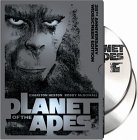Synopsis
An arrogant, misanthropic Charlton Heston leads a trio of astronauts who left Earth in 1972for a trip they expected to last some 900 years. 2000 years later, they crash-land on what theysuppose to be another planet. They encounter mute, primitive humans, but then are set upon bycivilized apes. Heston is the only survivor, and is befriended by ape scientists Roddy McDowalland Kim Hunter, who challenge the religious and scientific orthodoxy of their society bybelieving that a… Heston is intelligent; and b) there was another society that pre-existed the apes’.Of course, everybody knows what the final image of the movie is, and what that society was.
So the question is, given that everybody and his monkey knows what the film’s twist endingis, does the film still work, or do we just mark time, waiting for that big revelation? The answeris a resounding “yes” to the former. Planet of the Apes is one of that group of sciencefiction films, relatively rare on the whole, that is legitimately interested in its own concept, andworks it out to the fullest, rather than using it simply as an excuse for FX and action set-pieces.The topsy-turvy world, with humans at the bottom of the chain, opens up all sorts of satiricalpossibilities, and the film runs with them all. In its way, Planet of the Apes is similar inspirit to Jonathan Swift’s Gulliver’s Travels. While not as scabrous as that definitivesatire, and easily enjoyed by young viewers, the film nevertheless builds up a thoroughly scathingindictment of the human race. With Rod Serling as one of the screenwriters, the film’sintelligence and pointed social commentary should come as no real surprise.
Audio
Pretty snazzy formats for the sound — both 5.1 and DTS. The result is fine, but thelimitations of a 1968 soundtrack mean that the capabilities of these formats are hardly stretched.There is some decent surround presence from the music (one of Jerry Goldsmith’s moreunorthodox scores), and some solid rumbles from the rear during such scenes as the landing.Most of the sound is concentrated in the front speakers, however. There is simply a limitedamount that can be done with sound for this vintage. The dialogue is mostly clear, and thedistortions that occur are, again, inevitable a product of the times.
Video
Here (and with the extras) is where this edition improves most strikingly over the previousDVD release. While the initial version was in 2.35:1, it is only now that the picture isanamorphic. The colours are solid and very bright, with excellent contrasts and blacks. Thereis no edge enhancement to speak of, and the grin is extremely minor. The print is, barring acouple of very brief shots, in very good condition. All in all, as fine a transfer as one could hopefor.
Special Features
Disc 1 has two audio commentaries, and one text commentary. Jerry Goldsmith recallsworking on the music on one track, while the other has memories from Roddy McDowall,Natalie Trundy, Kim Hunter and make-up artist John Chambers. In both cases the memories areinteresting, but there are enormous gaps where nothing at all is being said. Given that McDowalldied in 1998, and Hunter died in 2002, I’m assuming this feature originally showed up on a laserdisc release. The text, provided by Eric Greene (author of “Planet of the Apes asAmerican Myth”) also has its gaps, and flashes by a bit quickly, but is also extremelyinformative.
Disc 2’s big feature is the 1998 two-hour-plus documentary Behind the Planet of theApes, which previously was released on its own. It covers the entire Apes phenomenon: allthe films, the TV series, the cartoon, the whole bit. It is hosted by McDowall, and may be a bitworshipful, but is still interesting. You can see the show’s promo too, should you so desire. Mostof the other extras are vintage featurettes of one sort or another: a 1966 make-up test withEdward G. Robinson and Heston; 20 minutes of home movies shot by McDowall on set (theseare silent films, but have been given a score); 20 minutes of silent outtakes and dalies;promotional featurettes from 1968 and 1972; footage of Don Taylor directing Escape fromthe Planet of the Apes and J. Lee Thompson doing the same for Conquest of the Planet ofthe Apes; and trailers for the whole series. The galleries include two print reviews (from Lifeand the Hollywood Reporter), a scored poster presentation, and scored merchandise andcollections galleries. There’s also a DVD-ROM chronology. The menus on both discs haveanimated and scored main screens and intros.
Closing Thoughts
This is the way the movie should have been released in the first place. But now it has beendone right.
Special Features List
- 2 Audio Commentaries
- Text Commentary
- “Behind the Planet of the Apes” Documentary
- 1966 Make-up Test
- Roddy McDowall Home Movies
- Outtakes and Dailies
- Trailers and Vintage Featurettes
- Reviews
- Scored Galleries (Posters, Merchandise, Collections)
- DVD-ROM Chronology




